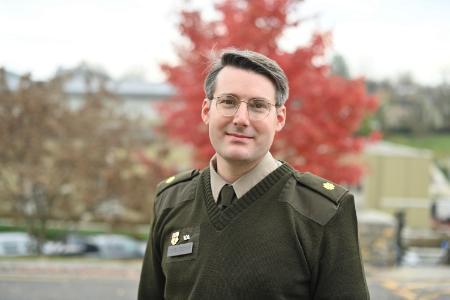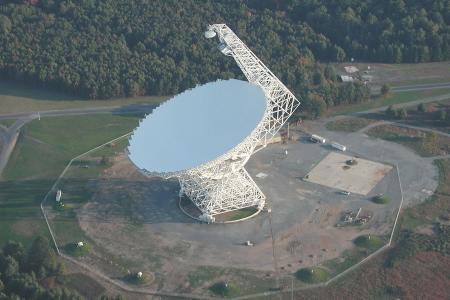VMI Chemistry Professor Published in Science Journals
LEXINGTON, Va. Nov. 20, 2024 — Maj. Christopher N. Shingledecker, assistant professor of chemistry at Virginia Military Institute, is a member of a research team responsible for discovering three new molecules in space. The team co-authored research articles recently published in Science and Nature Astronomy, two prestigious science journals, describing the observation of the molecules 1-, 2- and 4-cyanopyrene.
The project, called GOTHAM, was led by Shingledecker’s friend and colleague at the Massachusetts Institute of Technology (MIT) Department of Chemistry, Brett McGuire, Ph.D., and used astronomical data from space obtained by the Robert C. Byrd Green Bank Telescope (GBT), a 100-meter radio telescope in Green Bank, West Virginia.
 According to Shingledecker, until about the 1940s scientists did not think molecules could exist in space. “The belief was that there were just atoms floating around and that nothing as fragile as a chemical bond could survive. If a molecule did have the audacity to form, the idea was that ultraviolet light from stars would break it apart. Only in the post-World War II era did astronomers begin to realize the tremendous variety of molecules that exist in space. Amazingly, we now know of over 200,” he explained.
According to Shingledecker, until about the 1940s scientists did not think molecules could exist in space. “The belief was that there were just atoms floating around and that nothing as fragile as a chemical bond could survive. If a molecule did have the audacity to form, the idea was that ultraviolet light from stars would break it apart. Only in the post-World War II era did astronomers begin to realize the tremendous variety of molecules that exist in space. Amazingly, we now know of over 200,” he explained.
The GOTHAM team looks especially for so-called “aromatic” molecules in space.
“As the name suggests, these molecules sometimes have strong aromas, but in every case, if you look at the molecular structure, you’ll see one or more rings of carbon atoms. These are interesting from both an astronomical and a chemistry point of view. For example, if you look at the molecules which make up living things on Earth, you see these ring-like structures frequently, while in space we believe that up to 10% to 25% of all the carbon in the universe is in these multi-ring molecules which we call polycyclic aromatic hydrocarbons (PAHs). A fascinating implication of the fact that there is so much carbon floating around in space is that, if there’s life elsewhere in the universe, then there’s a good chance that it’s also carbon-based.” stated Shingledecker.
Specifically, the GOTHAM team studied the Taurus Molecular Cloud 1 (TMC-1), which lies within the Milky Way galaxy hundreds of light years from Earth. According to Shingledecker, molecular clouds like TMC-1 are a mixture of stardust and gas, mostly hydrogen, but mixed with many other molecules including PAHs.
“Understanding the chemistry of molecular clouds could one day shed light on how life began on Earth. We now know that comets and asteroids contain many of the molecular building blocks of life, such as amino acids and nucleobases. We suspect that these molecules may have initially formed in molecular clouds similar to TMC-1, which can go on to form solar systems like ours. From studying Earth and our own solar system, it is likely that there was a period billions of years ago when comets and asteroids hit the surface much more frequently than they do today, and planets around other stars almost certainly experience something very similar. Given what we now know about the presence of the molecular building blocks of life in comets and asteroids, it’s not hard to imagine the first organisms forming when some of those molecules encounter the right conditions on a young planet,” Shingledecker speculated.
Shingledecker received his doctorate from the University of Virginia, and has been a faculty member at VMI since August. He and his wife live in Lexington with their two young children.
The research article in Science may be viewed by going here. The research article in Nature Astronomy may be viewed by going here.
Marianne Hause
Communications & Marketing
VIRGINIA MILITARY INSTITUTE
.svg)
.png)